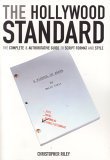Reviews
The
Hollywood Standard: The Complete and Authoritative Guide to Script Format and
Style
By
Christopher Riley

Publisher:
Michael Wiese Productions
Price:
£11.99
ISBN
1-932907-01-7
Review by
James MacGregor
My
first two thoughts on picking up any new book on scriptwriting are, “Does this
book fill a gap in the market?” and “Does it tell me anything new?” The
answer to both of those questions in regard to ‘The Hollywood Standard’ is,
without a doubt, a resounding yes.
This
isn’t a book that will teach you the intricacies of plot construction or the
difference between a three and four-act structure. This book is purely and
simply about showing you the best way to lay your script out on paper.
You
could be forgiven for thinking that in these days of word processors, script
templates and Final Draft that such a book would be completely redundant to all
but the absolute script novice. It’s entirely to Christopher Riley’s credit
that any such preconceptions I might have harboured before I started reading
were banished by page 14.
Christopher
Riley has an impressive track record when it comes to knowing about script
layout. He worked as a script reader at Warner Brothers’ script processing
department for over fourteen years. He rose to head the department and developed
their own in-house script layout software. In short, he has read thousands and
thousands of screenplays. He has seen countless mistakes made by writers over
the years and this book is the result of a professional lifetimes worth of
accumulated knowledge.
What
works so well about this book is that the author has used plenty of examples to
back up his layout advice. He gives you a scripted action sequence that is both
hard to read and confusing in terms of which character is doing what and the
time they do it. Then he shows you how he would lay out the exact same sequence.
The results really are dramatic. A dull, plodding sequence suddenly takes on
life. It lifts off the page. It achieves what any scriptwriter is trying to do -
make the words form pictures in the reader’s mind.
That’s
just one example of many. Riley works the same magic with the often badly used
Point-of-view shot. He shows how to get into it cleanly, so that the reader
isn’t confused about whose point of view we are looking at. He does the same
with flashbacks, montages, split screen sequences, foreign language dialogue,
and more. Every single one is backed up with clear, authoritative examples. You
can see that what he is saying makes sense. Script directions that start out
garbled and confusing are transformed into directions that are punchy, concise
and, most importantly, clearly understood.
He
also deals with the more mundane, but still vital, aspects of script layout.
Slug lines, beats and capitalisation of character names often confuse writers
and again Riley utilises lots of scripted examples to show how to use them
correctly within your script.
I
liked this book immensely. A confusingly written screenplay is a very
frustrating thing to read. Good ideas can become buried under layers of
confusing stage and camera directions. Any script that is confusing to read is
far more likely to be passed over by a script reader or potential producer
simply because they don’t have the time to try and decipher exactly what the
author is trying to say. It’s a sad fact of life that such a script is
unlikely to go into production and far more likely to go in to the bin.
In
“The Hollywood Standard”, Christopher Riley very clearly demonstrates the
difference that following a few simple layout guidelines can make to a script.
He does it with a quiet authority that’s very persuasive. You know that his
ideas work because you can see that they do. This is a book that I’m going to
be referring back to constantly from now on. Any scriptwriter, both new and
experienced, would be well advised to have a copy on their bookshelf. Highly
recommended.
| 


